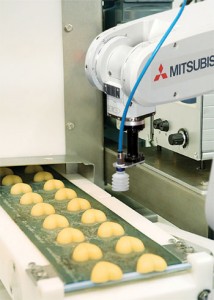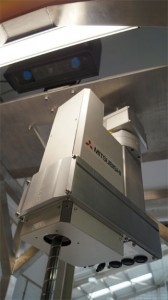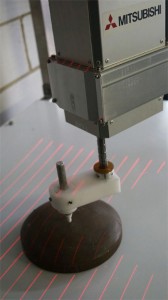Robots help food processors future proof their plants
 Ten years ago UK food prices were far lower than they are today – and since the bank collapse of 2008 many people have lower incomes. Food processers are aware of this and are increasingly looking to robots and automation to address their operating efficiency.
Ten years ago UK food prices were far lower than they are today – and since the bank collapse of 2008 many people have lower incomes. Food processers are aware of this and are increasingly looking to robots and automation to address their operating efficiency.
“There is a constant drive for improvement in food processing,” says John Rowley of automation and robot specialists Mitsubishi Electric. “The food manufacturers have already done wonders with automation and lean manufacturing, and increasingly they are discovering a new weapon in their armoury – robots!”
Pictured right: “Food manufacturers have already done wonders with automation and lean manufacturing, and increasingly they are discovering a new weapon in their armoury – robots!” explains John Rowley of Mitsubishi Electric.
Ten years ago there were very few robots in the food industry, and many production engineers were wary of them. They thought robots were expensive, complicated, unreliable and put people out of work. However a few crept in, often in the packaging section, and they are now increasingly spreading across the whole plant.
“Robots have many attributes that are particularly well suited to the food industry,” notes Rowley. “They are very flexible and can hold several programmes in their memory so they are able to easily switch from one production task to another. They do not tire and slow down, suffer from RSI, nor do unexpected things that could compromise safety, nor breathe pathogens into the workplace thus lengthening shelf life.”
Contrary to their appearance, robots can have a very delicate touch, reducing the risk of product damage and able to handle products such as cupcakes, sausages and poppadoms.
Let them eat cake
One example of a successful robot application is slicing iced cake. Using conventional automation would lead to some of the cake smearing onto the white icing. Instead a solution for achieving a clean cut with no smearing has been developed using an ultrasonic knife mounted on a multi-axis robot arm that can generate a complex motion profile to simultaneously cut through the cake while also synchronising with its movement along on a conveyor.
This solution proved to cost less than other options that were considered, reduced wastage, increased throughput and proved very hygienic and easy to clean.
 Elsewhere a Mitsubishi Electric robot has been used to achieve something that just a few years ago would have been thought impossible, the emulation of intuitive human cake icing movements.
Elsewhere a Mitsubishi Electric robot has been used to achieve something that just a few years ago would have been thought impossible, the emulation of intuitive human cake icing movements.
Quasar Automation wanted to create a system that could neatly apply icing or other embellishments to celebration cakes regardless of irregularities and imperfections in the cakes’ surface. To achieve this they have integrated a ceiling-mounted food safe robot from Mitsubishi Electric with a vision system and data processing software from Scorpion Vision.
Pictured left: A Mitsubishi Electric robot has been used to emulate intuitive human cake icing movements by integrating a ceiling-mounted food safe robot from Mitsubishi Electric with a vision system and data processing software from Scorpion Vision.
The top of any cake is far from smooth; in fact each one is uniquely uneven. When applying writing, such as ‘Happy Birthday’, or an image, the decorator intuitively adjusts to allow for the irregularities. Early attempts at automated icing effectively used 2D images, which distorted on the rough surface and rarely looked perfect.
Quasar specialises in automation for the food industry and in recent years has developed a growing interest in the potential of robots for food applications, so is particularly interested in Mitsubishi’s new F-series robots which include FDA, NFS and Food Sanitation Law compliant robots. These are based on a revolutionary new mechanical design and can be floor, wall or ceiling mounted. A powerful new controller and other high performance components, means they can attain precise positioning accuracy and high speed movements.
All cabling is fully enclosed for total hygiene. This includes pneumatic tubing and an Ethernet connection for specialist functions.
For the cake icing application, Quasar decided to use the F-series robot, ceiling-mounted in a dedicated cell. Utilising the Ethernet cable, a machine vision camera is mounted on the robot and the first step of the operation is to track the camera back and forth above the cake’s surface so that a 3D mapping of all the irregularities is produced.
Vision system
The vision system was developed with Scorpion Vision, whose Windows-based software can be combined with Gigabit Ethernet digital industrial cameras and bespoke lighting. The Windows format is familiar to almost everyone, so the system is far easier to use than those based on proprietary software.
With the 3D mapping compiled, the 2D image or decoration is compared to it and adjusted for any surface irregularities. Although this represents a substantial amount of data processing, it typically takes only about one second. From this data, the tracking path for the robot to apply the icing is calculated.
Rowley again: “To ensure even application, the robot keeps the icing gun – or other tool – a precise height above the surface of the cake. It follows the major contours and also smaller local bumps, dips and discontinuities, so it is a very detailed profile of vertical movements.”
 The automated system not only produces a consistent quality of product, it does it in a predictable time, so that production runs can be properly planned and scheduled.
The automated system not only produces a consistent quality of product, it does it in a predictable time, so that production runs can be properly planned and scheduled.
Pictured right: Contrary to their appearance, robots can have a very delicate touch, reducing the risk of product damage and able to handle products such as cupcakes, sausages and popadoms.
“Food and beverage producers are increasingly looking at robotic automation,” says Rowley. “To meet this emerging need the F-Series robots are designed to meet IP67, allowing easy cleaning of the arm, while food safe HG1 food grade grease is used for lubrication. For the ultra-hygienic pharmaceutical and medical sectors a cleanroom version meeting ISO 3 is available.”
Mitsubishi has robots working in many other food and drink facilities. Rowley again: “The old robot myths are evaporating fast. They typically cost £5/hr to operate, compared to +£10/hr to employ people, and because they don’t lose concentration or need rest breaks they are more productive. Typical return on investment for a robot is 18 months.”
It is also important to understand that robots create new types of rewarding jobs while relieving people of monotony, repetition and risk of injury. Robots need people to look after them and to work alongside them, say packing or inspecting, and if they secure a company’s future, they ensure secure jobs too. It is a fair estimate that on average a robot installation creates 2-3 jobs, and that the alternative to a robot is often outsourcing working to an overseas supplier.
“Robots have proved themselves in many industries and are now been taken up by the food and beverage sector,” sums up Rowley. “Five years ago there were very few robots in UK food processing facilities, but five years from now we will be wondering how they ever managed without them!”
Visit the Mitsubishi Electric website for more information.
See all stories for Mitsubishi Electric















